 [Portions reprinted from The Gentle Parent: Positive, Practical, Effective Discipline by L.R.Knost. Two Thousand Kisses a Day: Gentle Parenting Through the Ages and Stages and Whispers Through Time: Communication Through the Ages and Stages of Childhood now available on Amazon and through other major retailers.]
[Portions reprinted from The Gentle Parent: Positive, Practical, Effective Discipline by L.R.Knost. Two Thousand Kisses a Day: Gentle Parenting Through the Ages and Stages and Whispers Through Time: Communication Through the Ages and Stages of Childhood now available on Amazon and through other major retailers.]
Challenging behavior in our children can be really…well, challenging! How do you ‘handle’ a child who suddenly refuses to wear shoes or sit in her carseat/seatbelt or eat, period? Here are some tips to help you regain that snuggly, loving relationship you used to enjoy before your baby became a…gulp…PERSON!
1.) Remove the word ‘handle’ from your parenting vocabulary entirely. Your child isn’t a lion to be tamed or a dog to be trained! He’s a person, an individual with thoughts, interests, concerns, wants, and needs that are totally separate from yours. Respecting him as a separate individual not only models the value we need to place on others in our homes and communities, but also sets the stage for a mutually respectful relationship in his teen years and beyond.
2.) Slow down! Often simplifying our lives is the key to simplifying our parenting issues. Rushing a child from one activity to the next doesn’t expand her horizons; it stunts her creativity and inherent zest for life, which are the building blocks of a life-long love of learning. When she digs her heels in, pay attention! She’s trying to communicate a very deep need for time and space to learn about the world, to play and grow, and to just ‘be.’
3.) Small children have very little control over their lives, and the more powerless they feel, the more likely they are to make eating, getting dressed, going to the potty, etc. a battle of wills. Giving choices, engaging your child in making plans, and being flexible and responsive on a daily basis are good ‘proactive’ parenting, but little people are notorious for their awkward timing in deciding to suddenly assert their independence! Be prepared for those challenging moments by deciding ahead of time how you will respond. (See below for some ideas!)
4.) Listen, listen, listen! The first question parents ask me is almost always, “How do I get my child to listen?” And my first response is usually, “How well do you listen?” As Ralph Waldo Emerson so aptly put it, “What you do speaks so loud that I cannot hear what you say.” In other words, our children learn best by imitation. If every time our little ones ask for our attention we say, “Just a minute,” then we cannot expect instant attention from them. If when they speak to us our eyes constantly stray back to our computers and iPhones, we should not be surprised if they have a hard time looking at us when we ask them to. Listening is a two-way street that starts and ends with us, the adults.
5.) Boundaries are our friends! Many people believe that Gentle Parenting is a form of un-parenting, but nothing could be further from the truth. Gentle Parenting is involved parenting~interactive, engaged, active parenting. It takes focused attention, planning, participation, research, and so much more to be an empathetic, responsive parent who is in tune with their child’s needs and who is prepared to make whatever sacrifices are necessary to meet those needs. That said, in any home, like in any civilized society, boundaries are necessary for everyone’s safety and comfort. It is in the choosing and maintaining of those boundaries that Gentle Parenting distinguishes itself. In a gently parented home, boundaries are focused on guiding rather than controlling children and are maintained through empathetic and creative resolutions rather than harsh punitive consequences. (See below for some ideas!)
6.) Watch your attitude! Do you have angry eyes? A sharp tone? Do you issue commands and demand compliance? Do you sigh and roll your eyes when frustrated with your little one? All of these things contribute to creating resistance in children. Really, who wants to cooperate with someone who is demanding, impatient, sarcastic, angry, etc? Does feeling like a burden or a failure ever motivate anyone? Is a desire to please rooted in correction or connection? Think about how you like to be treated by authority figures (supervisors, law enforcement, etc.) and then treat your children the way you want to be treated! This not only reduces challenging behavior, but also models The Golden Rule~Do to others as you want them to do to you…an excellent life lesson!
Here are some ideas for your Gentle Parenting toolbox:
- Little one refusing to put on shoes before leaving the house? First, ask him why he doesn’t want to wear them. A toddler most likely won’t be able to/want to explain, but you’re modeling courtesy and opening up a dialogue, both good connection points. A three-year-old, though, might just surprise you with a very logical, in their own mind at least, response! Second, don’t react; just scoop the shoes up, and take them with you. If the refusal to wear shoes continues at the park/in the library/at the doctor’s office, etc. calmly tell him he can sit in your lap or in the stroller and hang out with you until he’s ready to wear his shoes.
- If a tantrum results, remember to stay calm (deep breathing, counting silently, and saying a quick prayer for guidance are all helpful!) and remain present. Some children respond well to a parent quietly talking, offering words to express what the child may be experiencing (i.e. “It’s frustrating when we have to do things we don’t like. I can see that you’re angry, and that’s okay. Let’s just sit here together for a while.”), while other children become more upset when a parent attempts to interact with them during a tantrum and are comforted simply by your quiet presence, a gentle back rub, or playing with a Calm-Me-Jar . Getting to know your child is an important part of Gentle Parenting and will help you to ‘read’ these situations so you can be responsive to their unique needs.
- A place for Time-Outs. Typically, I advise parents to use Time-Ins instead of Time-Outs in order to connect-to-correct, but there is one area that I advise the use of Time-Outs…the ‘Time-Out Toy Box!’ When a toy is misused (i.e. thrown, used to
 hit, drawn on, fought over, etc) and a gentle redirection has been given, the next step for the toy is to be put in the ‘Time-Out Toy Box.’ Little ones generally find the concept of a toy being put in Time-Out rather humorous and go along with the removal without a fuss (the toy can be returned after an exaggeratedly stern warning to the toy letting it know what is expected of it and that it must listen to ‘the boss’ ~the child, lol. They love that!), but remember to communicate, listen, and be flexible. If the removal of a toy brings about a strong negative response, it may be that the inappropriate behavior was more than just over-exuberance, in which case a Time-In might be needed. Again, being in tune with your child will help you to ‘read’ the situation and respond appropriately.
hit, drawn on, fought over, etc) and a gentle redirection has been given, the next step for the toy is to be put in the ‘Time-Out Toy Box.’ Little ones generally find the concept of a toy being put in Time-Out rather humorous and go along with the removal without a fuss (the toy can be returned after an exaggeratedly stern warning to the toy letting it know what is expected of it and that it must listen to ‘the boss’ ~the child, lol. They love that!), but remember to communicate, listen, and be flexible. If the removal of a toy brings about a strong negative response, it may be that the inappropriate behavior was more than just over-exuberance, in which case a Time-In might be needed. Again, being in tune with your child will help you to ‘read’ the situation and respond appropriately.
- The most challenging, independent children tend to be the ones who need the most intentional parental reconnection. Strong will=Strong need! It is often the strongest-willed children who identify most closely with their parents, oddly enough. While there is no denying how difficult it can be to raise a strong-willed child, seeing the purpose behind the behavior can make the journey much more manageable. Try to view their seemingly constant testing as them doing ‘research’ on you, seeing where your strengths and weaknesses are, and discovering all the ins and outs of being you. Also, taking the time to explain why you make the decisions you do, why you said this, why you didn’t say that, answering the endless questions patiently and openly, can alleviate some of the challenging behavior by offering them insights into who you are without them having to ‘dig’ it out of you!
Related posts:
Practical, Gentle, Effective Discipline
The Taming of the Tantrum: A Toddler’s Perspective
When Children Hit~10 Tips for Parents
Easy Peasy DIY Parenting Tools
To a Toddler Sharing is a 4 Letter Word~MINE!
Tots to Teens~Communication through the Ages and Stages
Parenting in Public: Toddler Time
 Award-winnning author, L.R.Knost, is the founder and director of the children's rights advocacy and family consulting group, Little Hearts/Gentle Parenting Resources, and Editor-in-Chief of Holistic Parenting Magazine. Books by L.R.Knost include Whispers Through Time: Communication Through the Ages and Stages of Childhood ; Two Thousand Kisses a Day: Gentle Parenting Through the Ages and Stages ; The Gentle Parent: Positive, Practical, Effective Discipline ; and Jesus, the Gentle Parent: Gentle Christian Parenting the first four books in the Little Hearts Handbook gentle parenting series, and children’s picture books Petey’s Listening Ears and the soon-to-be-released Grumpykins series.
Award-winnning author, L.R.Knost, is the founder and director of the children's rights advocacy and family consulting group, Little Hearts/Gentle Parenting Resources, and Editor-in-Chief of Holistic Parenting Magazine. Books by L.R.Knost include Whispers Through Time: Communication Through the Ages and Stages of Childhood ; Two Thousand Kisses a Day: Gentle Parenting Through the Ages and Stages ; The Gentle Parent: Positive, Practical, Effective Discipline ; and Jesus, the Gentle Parent: Gentle Christian Parenting the first four books in the Little Hearts Handbook gentle parenting series, and children’s picture books Petey’s Listening Ears and the soon-to-be-released Grumpykins series.
December 28, 2011 | Categories: calm me jar, communication, gentle discipline, gentle parenting, grace-based discipline, meltdown, positive discipline, preschooler, rebellion, soothing, tantrum, time-in, time-out, toddler | Tags: children, discipline, gentle discipline, gentle parenting, parenting, positive parenting, preschooler, rebellion, tantrum, time-in, time-out, toddler | 76 Comments »
[Reprinted from Two Thousand Kisses a Day: Gentle Parenting Through the Ages and Stages by L.R.Knost. Whispers Through Time: Communication Through the Ages and Stages of Childhood and The Gentle Parent: Positive, Practical, Effective Discipline also available through Amazon and other major retailers.]
 As babies grow from the newborn stage, through infancy, and into the toddler years, there is a natural and healthy progression toward independence that blossoms when a secure trust-foundation is in place. That trust-foundation is forged through the consistent meeting of a baby’s needs lovingly, gently, and empathetically by a primary caregiver.
As babies grow from the newborn stage, through infancy, and into the toddler years, there is a natural and healthy progression toward independence that blossoms when a secure trust-foundation is in place. That trust-foundation is forged through the consistent meeting of a baby’s needs lovingly, gently, and empathetically by a primary caregiver.
When a baby is breastfed, his mother is naturally close and available and, when parenting by following her maternal instincts, tends to be in tune with her baby in a beautiful symbiosis of unspoken communication. At some point, a baby will begin to ‘taste-test’ foods, learning through oral exploration about the textures and tastes of foods other than breastmilk. This progresses to a decrease in need for mommy’s milk for nutritional purposes, but is often accompanied by an unexpected and dramatic increase in demand to nurse which can be quite disconcerting, not to mention annoying!
Parents have a tendency to assign motives to their children’s behavior, typically based on their own childhood experiences and/or their adult perception of the circumstances. In the case of the increased demand for nursing which seems inversely proportional to the need for nursing, the motives parents often assign to their toddlers are ‘testing’ or ‘pushing boundaries.’
But think of it from the toddler’s perspective. They have been gradually moving away from their ‘source’ of all things and exploring what can be a big, scary world for a little person. No longer are they completely helpless, entirely dependent on another person for everything, but, as their independence has increased, so has their awareness of the world around them and their smallness by comparison. It is at this point that the all-important source of nutrition shifts into a support role, becoming, literally, a touchstone of security. A toddler’s increased need to nurse is, in fact, a need for reconnection and reassurance, not punishment!
Obviously, nursing every five minutes isn’t practical and can be downright uncomfortable, especially with the accompanying toddler ‘gymnurstics.’ But this is an excellent time for a parent to learn how to remain in tune with their child as the ages and stages go by. Paying attention to the needs behind the behaviors is an essential element in a healthy parent/child relationship, and, once a little one progresses beyond the basic needs stage, that learning curve can get pretty steep. This is a time when parents can begin experimenting with new ways to engage with their children to meet those reconnection needs in age-appropriate and relationship-building ways, an important skill that will serve parents well in the teen years!
Here are some things to try when faced with a toddler insisting on nursing every few minutes:
- Babywearing is one of my best tools, and I have a sling nearby for any time my toddler seems to need some closeness.
- Reading picture books is also a daily (actually, multiple times a day!) standard at our house, and when my little one toddles up to me, book in hand, I’ll plop down on the floor in whatever room I’m in and take a few minutes to read a book and talk about the pretty pictures.
- Sitting down together in the chair my toddler is used to nursing in and cuddling, reading, playing pat-a-cake, watching a DVD together, or even offering food or snacks to share, gives them a sense of sameness that is very reassuring.
- Playing games, making silly faces in the mirror, playing dress up together, taking walks, going to the park, anything that assures my toddler that I’m still available to her and enjoy being with her helps to meet the underlying need driving the nursing demands.
- Setting nursing boundaries and gently maintaining them might sound something like, “You can nurse once on each side, then we’re all done for now,” or “We’ll nurse before bedtime, and then we’ll cuddle until you go to sleep.” Don’t be afraid to set boundaries, but make sure to stay in-tune with your toddler and offer the connection and comfort they need to stay secure in their relationship with you as you move through this big transition in their life.
The main message here is to try different things until you find what works for you and your child, always focusing on staying connected and responsive to your little one’s needs. Change can be difficult for both parents and children, but it can be an exciting time, too, as you get to grow with your child into the next stage of life!
Related posts:
Picky Eater? Here’s Help!
Love in the Time of Cosleeping
And Baby Makes Three~Surviving the first three months with a newborn!
A Boy, A Girl, and A Baby~Journey to Gentle Parenting
Babywearing Basics Resource Guide
Practical Gentle Discipline Guide
Toddlers, Tantrums, and Time-Ins, Oh My!
Parenting in Public: Toddler Time
Testing the Boundaries~What’s A Parent To Do?
Playground Confessions~Look Who’s Talking!
 Award-winnning author, L.R.Knost, is the founder and director of the children's rights advocacy and family consulting group, Little Hearts/Gentle Parenting Resources, and Editor-in-Chief of Holistic Parenting Magazine. Books by L.R.Knost include Whispers Through Time: Communication Through the Ages and Stages of Childhood ; Two Thousand Kisses a Day: Gentle Parenting Through the Ages and Stages ; The Gentle Parent: Positive, Practical, Effective Discipline ; and Jesus, the Gentle Parent: Gentle Christian Parenting the first four books in the Little Hearts Handbook gentle parenting series, and children’s picture books Petey’s Listening Ears and the soon-to-be-released Grumpykins series.
Award-winnning author, L.R.Knost, is the founder and director of the children's rights advocacy and family consulting group, Little Hearts/Gentle Parenting Resources, and Editor-in-Chief of Holistic Parenting Magazine. Books by L.R.Knost include Whispers Through Time: Communication Through the Ages and Stages of Childhood ; Two Thousand Kisses a Day: Gentle Parenting Through the Ages and Stages ; The Gentle Parent: Positive, Practical, Effective Discipline ; and Jesus, the Gentle Parent: Gentle Christian Parenting the first four books in the Little Hearts Handbook gentle parenting series, and children’s picture books Petey’s Listening Ears and the soon-to-be-released Grumpykins series.
December 15, 2011 | Categories: attachment parenting, baby led weaning, babywearing, books, breastfeeding, children's books, communication, food, gentle parenting, natural parenting, nursing, toddler | Tags: attachment parenting, baby led weaning, babywearing, breastfeeding, Christian children's books, food, gentle parenting, nursing, parenting, play, positive parenting, toddler | 7 Comments »
[Excerpt reprinted from Jesus, the Gentle Parent: Gentle Christian Parenting by L.R.Knost. Two Thousand Kisses a Day: Gentle Parenting Through the Ages and Stages; Whispers Through Time: Communication Through the Ages and Stages of Childhood; and The Gentle Parent: Positive, Practical, Effective Discipline also available on Amazon and through other major retailers.]
~~~~~~~~~~~~~~~~~~~~~
 St.Nicholas was just a man, but he was a man with a mission. Born in the third century, he grew up to be an intensely kind-hearted man who was especially devoted to children’s issues and helping the poor. He was a Greek Bishop who defied the established Church in order to go out among the ‘unwashed masses’ and live his life as the ‘heart and hands of Jesus.’ While many miracles and legends about him evolved through the centuries, his penchant for leaving secret gifts is the one that captured the hearts and imaginations of people world-wide, leading to the present-day legend of Santa Claus.
St.Nicholas was just a man, but he was a man with a mission. Born in the third century, he grew up to be an intensely kind-hearted man who was especially devoted to children’s issues and helping the poor. He was a Greek Bishop who defied the established Church in order to go out among the ‘unwashed masses’ and live his life as the ‘heart and hands of Jesus.’ While many miracles and legends about him evolved through the centuries, his penchant for leaving secret gifts is the one that captured the hearts and imaginations of people world-wide, leading to the present-day legend of Santa Claus.
I, like many new parents, struggled with the idea of perpetuating a ‘false belief’ and thus undermining my children’s trust. But then I turned to the Bible and saw how Jesus, who spoke absolute truth always, often spoke that truth in stories. He knew something about people’s hearts that I needed to learn as a young parent. He knew that the human mind is logic, analysis, reason, and that the human heart is imagination, creativity, love. He knew that sometimes you have to bypass people’s minds and speak straight to their hearts, those well-springs of wonder, for true understanding to occur and that often the deepest truths are the ones that are too big for the human mind to receive and can only be grasped by the heart.
When it comes to the breathtaking gift of the Christ-Child, the Eternal Creator born of a woman, God Himself wrapped in swaddling clothes, the I AM in a manger, what better way to share such an absurd and immense truth than Jesus’ way…with a story? How else would my little ones be able to grasp the concept of such a gift?  How would they embrace the wonder? How could I possibly break down the impossible into a pedantic lecture? Would the improbable make more sense in a dissertation?
How would they embrace the wonder? How could I possibly break down the impossible into a pedantic lecture? Would the improbable make more sense in a dissertation?
And so I chose the way of the parable. I embraced Christmas in all its glory, decorated and baked and showered my little ones with gifts, all while sharing the story of the birth of a Baby. Woven through every event, every tradition, every memorable moment of our family’s Christmas, is the celebration of the wondrous gift of a Savior. We watch Rudolph the Red-Nosed Reindeer, Santa Claus is Coming to Town, and all the other fun Christmas shows together. We read bedtime stories about Christmas elves and magical toys and talking animals. And when my children ask me if Santa really exists, I tell them yes, because it’s true. Every parent who carries on St. Nicholas’ tradition of leaving secret gifts, of being the heart and hands of Jesus, of sharing the wonder, excitement, and glory of the most extraordinary Gift ever given to mankind, every one of us is Santa Claus.
My children never outgrow their belief in Santa. When they’re ready we simply share the beautiful story of St. Nick and invite them to join us in the fun of becoming Santa for their younger siblings and for children in need in our community. They still get presents, of course, but they also get to experience a new facet of the wonder of Christmas through the excitement of secret-keeping and present-wrapping and plan-making and joy-giving. Becoming Santa is an exciting and wonder-filled experience for our children, a step toward adulthood that makes them feel like they’ve been entrusted with a wonderful secret and gives them an opportunity to experience the incredible joy of generosity.
Note: I don’t ever use Santa Claus as a threat (i.e. “I’m calling Santa right now if you don’t…” or “Santa’s watching, and you won’t get any presents for Christmas if…”) first because a parable’s purpose is to teach, not to manipulate or control, and second because what I am teaching is the wonder and miracle of receiving a free gift, one that can’t be earned because it is freely given. Manipulating my children into ‘performing’ might work temporarily, but am I really trying to raise works-driven Christians, or am I trying to teach my little people about the wonderful gift of grace?
Here are some of the ways we focus on Jesus for Christmas:
Children learn best and most happily through play, so letting my little people ‘play Santa’ (i.e. wrapping up their toys and ‘surprising’ each other, making ornaments and delivering them to a nursing home, shopping at the dollar store for Operation Christmas Child, etc.) is a very important part of our Christmas traditions. And the best part is…they’re playing Santa for Jesus!
Leading up to Christmas, we marvel about how Jesus loves us so much He wants us to get presents on His birthday (truly awe-inspiring to children and a lesson in sacrificial giving!) because all He wants for His birthday are smiles and happy hearts.
Then we brainstorm ways to give Jesus as many ‘birthday presents’ as possible (a lesson in generosity). We work together to share Christmas cheer with everyone we meet, but focus our best efforts on the grumpiest people because they don’t smile as often and so their smiles make really special gifts for Jesus (a lesson in unconditional love).
We have a 12 Days of Christmas tradition where everyone gets a small present (chocolate, a special pencil, etc), and we read Christmas picturebooks every evening, building excitement for the Christmas morning celebration of the BEST GIFT EVER!
On Christmas Eve, we go to a special church service and then, after celebrating Christmas with family, we go home and make a fire in the fireplace (in Florida weather!) and make s’mores and hot chocolate and read the story of Jesus’ birth from Luke.
Then, on Christmas morning, we have a ‘Happy Birthday, Jesus’ party before opening presents, complete with a birthday cake and candles and singing ‘Happy birthday to Jesus!’
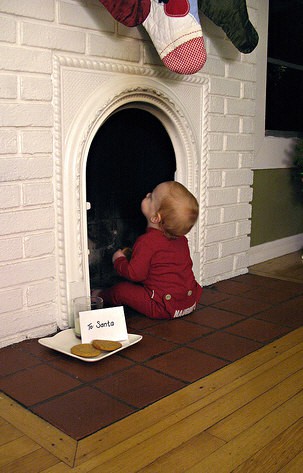
Here are some other resources on making the meaning of Christmas central to your celebrations this year (I’ll be adding more as I find them):
Celebrating Jesus with a Santa Claus Christmas
24 Tips for a Safe, Stress-Free & Jolly Holiday… A Very Toddler Christmas
7 Tips and Traditions to Make Giving a Standard of Living
What traditions does your family have to keep Christ in Christmas? Share them in the comment section!

 Award-winnning author, L.R.Knost, is the founder and director of the children's rights advocacy and family consulting group, Little Hearts/Gentle Parenting Resources, and Editor-in-Chief of Holistic Parenting Magazine. Books by L.R.Knost include Whispers Through Time: Communication Through the Ages and Stages of Childhood ; Two Thousand Kisses a Day: Gentle Parenting Through the Ages and Stages ; The Gentle Parent: Positive, Practical, Effective Discipline ; and Jesus, the Gentle Parent: Gentle Christian Parenting the first four books in the Little Hearts Handbook gentle parenting series, and children’s picture books Petey’s Listening Ears and the soon-to-be-released Grumpykins series.
Award-winnning author, L.R.Knost, is the founder and director of the children's rights advocacy and family consulting group, Little Hearts/Gentle Parenting Resources, and Editor-in-Chief of Holistic Parenting Magazine. Books by L.R.Knost include Whispers Through Time: Communication Through the Ages and Stages of Childhood ; Two Thousand Kisses a Day: Gentle Parenting Through the Ages and Stages ; The Gentle Parent: Positive, Practical, Effective Discipline ; and Jesus, the Gentle Parent: Gentle Christian Parenting the first four books in the Little Hearts Handbook gentle parenting series, and children’s picture books Petey’s Listening Ears and the soon-to-be-released Grumpykins series.
December 5, 2011 | Categories: Advent, Bible, books, children's books, Christian, Christian parenting, Christmas, family, Jesus, Santa Claus, St. Nicholas, traditions | Tags: bedtime stories, Bible, childhood, children, children's books, Christian children's books, Christian parenting, Jesus, parenting, play, sacrifice, Santa Claus, St. Nicholas, traditions | 19 Comments »
This is for all you mamas who see the creative projects and crafts and cute baking on Pinterest and wish you were the kind of ‘crafty mama’ who could whip together such adorableness for your little ones. I, too, wish I was a crafty mama and have pinned so many great ideas and tried a few with…let’s just say less-than-stellar results, lol. But my children have loved every flub, giggled at every failure, and laughed their way through every project regardless of the results. There’s joy in the journey, mamas, so take heart and grab some of these ideas and flub and fail your way to a happy, craft-astic holiday!
Here’s a project that didn’t turn out as intended. (From the creative genius Play at Home Mom, who made a beautifully flat and festively decorated ice rink which mine doesn’t remotely resemble, haha. Head over to her site for some really great ideas!)

But, even though my ice rink somehow ended up with a mysterious growth, my little people loved it just the same. In fact, they really enjoyed the ice mountain (aka ‘growth’) and used it for some Florida sledding!
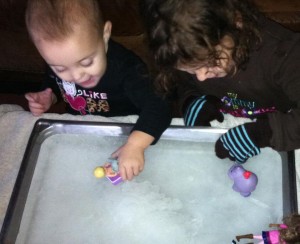
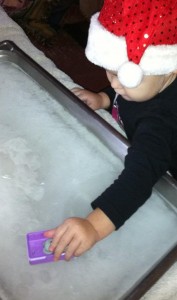
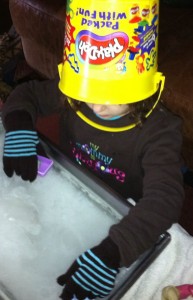
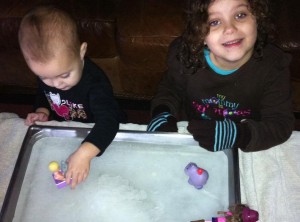
And here are some other ideas I’m planning to ruin, er…try out for some Christmas fun!
This site has some really cute Advent ideas for using picture books!

~And these cute ideas are from Pinterest!~
My most recent craft-aster: setting Christmas gifts on fire last night! So, fyi, coffee beans are flammable (who knew?). The candle needs to be in a glass votive and high enough out of the coffee so the beans won’t fall in and catch fire. Mine didn’t even vaguely resemble the adorable ones pictured below (pre or post fire, lol), so click on the picture to get instructions if you want to make them!





 Award-winnning author, L.R.Knost, is the founder and director of the children's rights advocacy and family consulting group, Little Hearts/Gentle Parenting Resources, and Editor-in-Chief of Holistic Parenting Magazine. Books by L.R.Knost include Whispers Through Time: Communication Through the Ages and Stages of Childhood ; Two Thousand Kisses a Day: Gentle Parenting Through the Ages and Stages ; The Gentle Parent: Positive, Practical, Effective Discipline ; and Jesus, the Gentle Parent: Gentle Christian Parenting the first four books in the Little Hearts Handbook gentle parenting series, and children’s picture books Petey’s Listening Ears and the soon-to-be-released Grumpykins series.
Award-winnning author, L.R.Knost, is the founder and director of the children's rights advocacy and family consulting group, Little Hearts/Gentle Parenting Resources, and Editor-in-Chief of Holistic Parenting Magazine. Books by L.R.Knost include Whispers Through Time: Communication Through the Ages and Stages of Childhood ; Two Thousand Kisses a Day: Gentle Parenting Through the Ages and Stages ; The Gentle Parent: Positive, Practical, Effective Discipline ; and Jesus, the Gentle Parent: Gentle Christian Parenting the first four books in the Little Hearts Handbook gentle parenting series, and children’s picture books Petey’s Listening Ears and the soon-to-be-released Grumpykins series.
December 1, 2011 | Categories: Advent, bookish, books, children's books, Christmas, family, food, life, pinterest | Tags: Advent, bedtime stories, childhood, children, children's books, Christmas, crafts, family, food, Pinterest, play | 2 Comments »
 [Portions reprinted from The Gentle Parent: Positive, Practical, Effective Discipline by L.R.Knost. Two Thousand Kisses a Day: Gentle Parenting Through the Ages and Stages and Whispers Through Time: Communication Through the Ages and Stages of Childhood now available on Amazon and through other major retailers.]
[Portions reprinted from The Gentle Parent: Positive, Practical, Effective Discipline by L.R.Knost. Two Thousand Kisses a Day: Gentle Parenting Through the Ages and Stages and Whispers Through Time: Communication Through the Ages and Stages of Childhood now available on Amazon and through other major retailers.] hit, drawn on, fought over, etc) and a gentle redirection has been given, the next step for the toy is to be put in the ‘Time-Out Toy Box.’ Little ones generally find the concept of a toy being put in Time-Out rather humorous and go along with the removal without a fuss (the toy can be returned after an exaggeratedly stern warning to the toy letting it know what is expected of it and that it must listen to ‘the boss’ ~the child, lol. They love that!), but remember to communicate, listen, and be flexible. If the removal of a toy brings about a strong negative response, it may be that the inappropriate behavior was more than just over-exuberance, in which case a Time-In might be needed. Again, being in tune with your child will help you to ‘read’ the situation and respond appropriately.
hit, drawn on, fought over, etc) and a gentle redirection has been given, the next step for the toy is to be put in the ‘Time-Out Toy Box.’ Little ones generally find the concept of a toy being put in Time-Out rather humorous and go along with the removal without a fuss (the toy can be returned after an exaggeratedly stern warning to the toy letting it know what is expected of it and that it must listen to ‘the boss’ ~the child, lol. They love that!), but remember to communicate, listen, and be flexible. If the removal of a toy brings about a strong negative response, it may be that the inappropriate behavior was more than just over-exuberance, in which case a Time-In might be needed. Again, being in tune with your child will help you to ‘read’ the situation and respond appropriately. Award-winnning author, L.R.Knost, is the founder and director of the children's rights advocacy and family consulting group, Little Hearts/Gentle Parenting Resources, and Editor-in-Chief of Holistic Parenting Magazine. Books by L.R.Knost include Whispers Through Time: Communication Through the Ages and Stages of Childhood ; Two Thousand Kisses a Day: Gentle Parenting Through the Ages and Stages ; The Gentle Parent: Positive, Practical, Effective Discipline ; and Jesus, the Gentle Parent: Gentle Christian Parenting the first four books in the Little Hearts Handbook gentle parenting series, and children’s picture books Petey’s Listening Ears and the soon-to-be-released Grumpykins series.
Award-winnning author, L.R.Knost, is the founder and director of the children's rights advocacy and family consulting group, Little Hearts/Gentle Parenting Resources, and Editor-in-Chief of Holistic Parenting Magazine. Books by L.R.Knost include Whispers Through Time: Communication Through the Ages and Stages of Childhood ; Two Thousand Kisses a Day: Gentle Parenting Through the Ages and Stages ; The Gentle Parent: Positive, Practical, Effective Discipline ; and Jesus, the Gentle Parent: Gentle Christian Parenting the first four books in the Little Hearts Handbook gentle parenting series, and children’s picture books Petey’s Listening Ears and the soon-to-be-released Grumpykins series.

 As babies grow from the newborn stage, through infancy, and into the toddler years, there is a natural and healthy progression toward independence that blossoms when a secure trust-foundation is in place. That trust-foundation is forged through the consistent meeting of a baby’s needs lovingly, gently, and empathetically by a primary caregiver.
As babies grow from the newborn stage, through infancy, and into the toddler years, there is a natural and healthy progression toward independence that blossoms when a secure trust-foundation is in place. That trust-foundation is forged through the consistent meeting of a baby’s needs lovingly, gently, and empathetically by a primary caregiver. St.Nicholas was just a man, but he was a man with a mission. Born in the third century, he grew up to be an intensely kind-hearted man who was especially devoted to children’s issues and helping the poor. He was a Greek Bishop who defied the established Church in order to go out among the ‘unwashed masses’ and live his life as the ‘heart and hands of Jesus.’ While many miracles and legends about him evolved through the centuries, his penchant for leaving secret gifts is the one that captured the hearts and imaginations of people world-wide, leading to the present-day legend of Santa Claus.
St.Nicholas was just a man, but he was a man with a mission. Born in the third century, he grew up to be an intensely kind-hearted man who was especially devoted to children’s issues and helping the poor. He was a Greek Bishop who defied the established Church in order to go out among the ‘unwashed masses’ and live his life as the ‘heart and hands of Jesus.’ While many miracles and legends about him evolved through the centuries, his penchant for leaving secret gifts is the one that captured the hearts and imaginations of people world-wide, leading to the present-day legend of Santa Claus. How would they embrace the wonder? How could I possibly break down the impossible into a pedantic lecture? Would the improbable make more sense in a dissertation?
How would they embrace the wonder? How could I possibly break down the impossible into a pedantic lecture? Would the improbable make more sense in a dissertation?



















